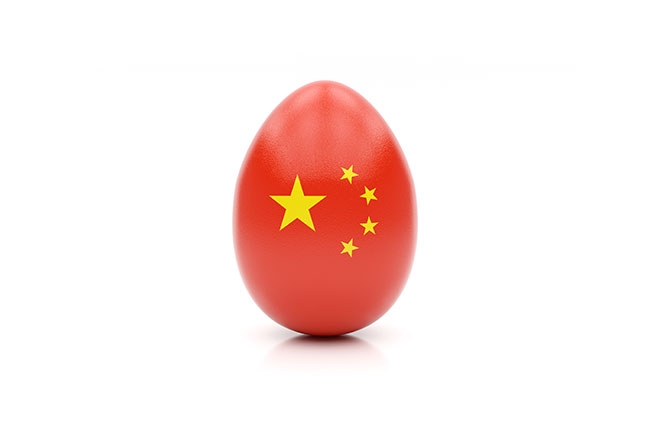
China’s poultry industry in transition
By Lilian Schaer
Features Business & Policy TradeModernization and shifting consumer preferences are creating new market opportunities.
 China is the world leader by far with 29.9 million metric tons in 2015, followed distantly by the United States and India, which produced 5.7 and 4.3 million tons respectively during the same period. One metric ton of eggs is the equivalent of 18,895 eggs. Photo: Getty Images
China is the world leader by far with 29.9 million metric tons in 2015, followed distantly by the United States and India, which produced 5.7 and 4.3 million tons respectively during the same period. One metric ton of eggs is the equivalent of 18,895 eggs. Photo: Getty ImagesFor most marketers and producers of goods, the Chinese market spells opportunity. After all, the world’s most populous country boasts a potential 1.4 billion customers and its middle class and consumer purchasing power are both on the rise.
Research by consultants McKinsey & Co. suggests that by 2022, more than three-quarters of China’s urban consumers will earn between 60,000 and 229,000 Yuan Renminbi (approximately $11,600 to $44,400) a year. Only four per cent of urban Chinese households’ earnings were in that range in 2002, but that figure had already increased to 68 per cent by 2012.
That change can be attributed directly to the rapid pace of industrialization and urbanization that has been ongoing in China since the 1980s. According to the World Bank, only 16 per cent of China’s population lived in urban areas in 1960. That figure increased to 56 per cent in 2015 and is expected to reach 60 per cent by 2020. Today, 188 of its cities are larger than Chicago and the country’s rapid pace of change continues unabated.
According to Dr. Mark Lyons, global vice-president and head of Greater China for Alltech, it takes courage and commitment to succeed in the Chinese market, where transparency is the new focus. Lyons spoke at a breakfast event at the International Production and Processing Expo in Atlanta this past winter.
Along with other sectors, China’s agriculture, too, has been modernizing and mechanizing at an astonishing rate, with farm land consolidation creating larger farms and enabling implementation of new food safety and quality rules and a growing focus on the environment.
The feed sector is also consolidating, Lyons said. Alltech’s 2017 Global Feed Survey shows China is still the world’s largest feed producer, but the country’s feed mill count has declined by almost 30 per cent as the sector evolves from one that is fragmented to one that is segmented and integrated into the food chain.
Twenty per cent of the world’s poultry is in China, including 8.8 billion broilers, 1.2 billion layers/breeders and four billion water fowl. One-quarter of layer farms are considered large, with more than 50,000 birds, and 33 per cent are mid-scale, with 20,000 to 50,000 birds per farm.
China presently produces approximately one-quarter of the world’s poultry meat, with projections showing both production and consumption increasing in the next decade. With respect to egg production, China is the world leader by far with 29.9 million metric tons in 2015, followed distantly by the United States and India, which produced 5.7 and 4.3 million tons respectively during the same period. One metric ton of eggs is the equivalent of 18,895 eggs.
Lyons listed five key trends driving poultry industry change in China: growing integration in the egg and poultry sectors; growing consumer awareness of environmental pollution caused by farming that is putting pressure on farms; need for antibiotic-free production as testing and legislation become stricter; consumer demands for quality; and high feed costs.
High feed costs are also one of the industry’s biggest challenges, with corn, which makes up 80 per cent of China’s poultry rations, costing more than twice the international market price. Persistent disease outbreaks result in expensive losses for the industry and hamper consumer confidence.
Exports are declining as China faces stiff competition from Brazil and Thailand in Japan – its biggest international market – and domestic consumption is flat-lining as chicken is considered a lower class protein compared to pork, seafood and beef.
As China becomes wealthier, consumers are starting to pay more attention to issues like production standards, quality, animal welfare and the environment.
Strict new laws governing pollution from livestock farms, air quality, animal care and disease control, water quality and standardized large-scale production have been introduced that are putting pressure on farms to achieve compliance. For farms that don’t comply, or are located in areas the government has designated not suitable for commercial livestock production, a national farm shutdown policy is in place.
According to Lyons, any foreign companies hoping to successfully do business in China must be in the country and be prepared to make a long-term commitment to the market. China is different than other countries and building a business there is not for the faint of heart, he said.
Print this page